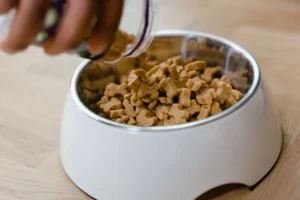Cats are known for their picky eating habits, but have you ever noticed your feline friend showing a particular interest in almond milk? You’re not alone in wondering why your cat enjoys this non-dairy alternative. Let’s explore the reasons behind your cat’s fascination with almond milk.
Answer: Cats may be drawn to almond milk due to its creamy texture and nutty flavor, which can be appealing to their taste buds. However, it’s important to understand that almond milk should only be given to cats in moderation, as it lacks essential nutrients that cats need in their diet.
Is Almond Milk Safe for Cats to Consume?
You may be wondering whether almond milk is safe for your feline friend to drink. While almond milk is not toxic to cats, it’s important to note that cats are obligate carnivores, meaning their diet should primarily consist of meat. Almond milk does not provide the necessary nutrients that cats need for optimal health.
Feeding your cat almond milk as a treat occasionally is unlikely to cause harm, but it should not be a regular part of their diet. Almond milk is low in protein and essential nutrients, so it’s best to stick to cat-specific products or consult your veterinarian for nutrition advice.
When it comes to hydration, fresh water is always the best choice for cats. If you’re looking for an alternative to dairy milk, there are specialized cat milk products available that are specifically formulated for feline nutrition.
Remember, cats have unique dietary needs, and it’s essential to prioritize their health and well-being by providing them with balanced nutrition tailored to their species.
Nutritional Benefits of Almond Milk for Cats
While almond milk is not an ideal source of nutrition for cats, it does offer some potential benefits. Almond milk is low in calories and fat, which can be beneficial for overweight cats or those with digestive sensitivities to traditional dairy products.
However, it’s important to note that cats have specific nutritional needs that are best met through a meat-based diet. Almond milk does not provide the protein or amino acids that cats require for optimal health.
If you’re considering incorporating almond milk into your cat’s diet, it’s crucial to do so in moderation and as an occasional treat. Always prioritize species-appropriate nutrition for your feline friend’s overall well-being.
Additionally, consult your veterinarian before making any significant changes to your cat’s diet to ensure they are receiving the essential nutrients they need for a healthy and happy life.
For more information on cat nutrition, check out this helpful resource from the American Association of Feline Practitioners: American Association of Feline Practitioners – Feline Nutrition.
Remember, your cat’s diet plays a crucial role in their overall health and longevity, so make informed choices that prioritize their well-being.
Alternative Dairy-Free Milk Options for Cats
If your cat enjoys almond milk but you’re looking for other dairy-free alternatives, consider coconut milk or oat milk. These options are less likely to cause digestive issues in cats compared to almond milk. Always ensure the milk is unsweetened and free from any additives that could be harmful to your furry friend. Remember, moderation is key when introducing new foods to your cat’s diet, so start with small amounts and monitor their reaction closely.
Signs of Allergic Reactions in Cats to Almond Milk
While some cats may enjoy almond milk, it’s essential to be aware of potential allergic reactions. If your cat displays symptoms such as vomiting, diarrhea, skin irritation, or difficulty breathing after consuming almond milk, it may indicate an allergic reaction. In such cases, it’s best to consult your veterinarian immediately to determine the best course of action for your cat’s health and well-being.
For more information on identifying and managing allergic reactions in cats, you can refer to the American Society for the Prevention of Cruelty to Animals (ASPCA) guide on food allergies in cats. This resource offers valuable insights and tips on how to recognize and address allergic reactions in feline companions.
Proper Way to Introduce Almond Milk to Cats
If you’re wondering why your cat enjoys almond milk, it may be due to its creamy texture and slightly sweet taste. However, it’s essential to introduce almond milk to your feline friend’s diet cautiously. Almond milk should only be given as an occasional treat and not as a substitute for water or their regular cat food. Begin by offering a small amount of almond milk and observe how your cat reacts. Monitor for any signs of digestive upset such as diarrhea or vomiting. If your cat tolerates the almond milk well, you can gradually increase the amount but always in moderation. Remember, cats are obligate carnivores and should primarily consume a diet rich in animal protein.
Importance of Consulting a Veterinarian
Before adding almond milk or any new food to your cat’s diet, it’s crucial to consult with a veterinarian. While some cats may enjoy almond milk without any issues, others could have allergies or sensitivities to certain ingredients in the milk. A veterinarian can provide personalized advice based on your cat’s individual health needs. Additionally, almond milk may not provide the necessary nutrients that cats require in their diet. A professional opinion can help ensure that your cat’s nutritional needs are being met appropriately. When it comes to your furry friend’s well-being, it’s always best to seek expert guidance.
Unique Insight: Essential Nutrients for Cats
Apart from the occasional treat like almond milk, cats require specific nutrients for optimal health. Protein, taurine, and various vitamins and minerals are crucial components of a cat’s diet. Consult with your veterinarian to ensure your cat is receiving a balanced and nutritious diet tailored to their needs. Remember, what your cat consumes plays a significant role in their overall health and well-being.
Homemade Almond Milk Recipes for Cats
Are you looking for a special treat to spoil your feline friend? Homemade almond milk can be a delightful option for your furry companion. Almond milk for cats can be a great alternative to dairy milk, especially if your cat is lactose intolerant. Plus, it’s easy to make right in your kitchen!
To whip up a batch of homemade almond milk for cats, simply blend together soaked almonds with water, and strain out the pulp. You can sweeten it with a bit of honey or maple syrup, but remember that cats don’t need added sugars in their diet. It’s best to keep it simple and natural.
Remember, almond milk should only be given to cats as an occasional treat, as it doesn’t provide all the nutrients they need. Also, it’s essential to make sure your cat isn’t allergic to almonds before offering them almond milk. If you notice any negative reactions, discontinue feeding them almond milk right away.
For a special bonding experience with your kitty, try making them a small batch of homemade almond milk and enjoy watching them savor this delightful treat!
Fun Facts About Cats and Almond Milk
Did you know that the reason cats are so fond of almond milk might actually be related to the aroma rather than the taste? Cats are attracted to the smell of almond milk due to the nutty fragrance it emits. This aroma piques their curiosity and can make almond milk a fascinating beverage for them to investigate.
Moreover, almonds themselves are not toxic to cats, which could explain why they show interest in almond milk. While almonds should not be a regular part of their diet due to potential choking hazard, almond milk in moderation can be a safe and enjoyable treat for your furry friend.
Another interesting fact is that cats are known for their sense of adventure and curiosity, so offering them new and intriguing treats like almond milk can stimulate their inquisitive nature and provide them with mental enrichment.
So, the next time your cat shows interest in your almond milk, remember that it might be more about the smell and novelty than the actual taste – it’s all part of their playful and curious nature!
Alex, a passionate animal lover, has experience in training and understanding animal behavior. As a proud pet parent to two dogs and three cats, he founded AnimalReport.net to share insights from animal experts and expand his knowledge of the animal kingdom.




